![]()
 |
Nissan LeafThe Leaf Arrives! |
|
Today our Leaf arrived! After several months of waiting and anxiety over the possibility that the disaster in Japan had thrown another wrench into the delivery schedule*, we were happy to hear on Wednesday from Paul Scott at Santa Monica Nissan that our car was ready.
First ImpressionsWith the understanding that it has been less than 24 hours since getting the car... my initial impressions are that the car is the quietest EV we've had so far. The body seems very well insulated from road noise, and there is just the barest hint of whine from the gears. The interior is also mercifully insulated from the artificially generated sounds which are now required when the car is moving a low speed. These can be turned off with a button press, but annoyingly, that must be done each time the car is turned on.
But one refreshing change is to find numerous readouts of power use in real units of kilowatts (Kw). There are indicators (see below) showing the actual power being used by the heating/cooling, lights, regenerative braking, and propulsion. Notably lacking, however, is a digital readout of state of charge. This is only given in the form of estimated range remaining (depending on average use over the last few miles) and an "analog" gage with 12 unlabeled divisions. A digital readout of % charge remaining would have been very useful.
Charging has also gone smoothly, though slowly compared to all of the other EV's we've had. The car is limited to a 3.3 Kw charge rate with the 240V charger connection. We are using the same Clipper Creek charger we used for our Mini E, which charged at a 6.6 Kw rate. Incidentally, this charger was upgraded to the now standard J1772 charger connector with just a charging cord swap-out kit from Clipper Creek, saving us the trouble of having to install yet another kind of charger on the garage wall.
Rough EdgesPhysically, the Leaf looks and feels like a nicely polished design, but there are numerous rough edges in the electronics/software. First off, while the bluetooth connection to my phone (a Motorola Droid) is nice and includes the ability to play music on the phone, the car assumes that upon connecting to my phone, it should automatically start the music or podcast I was listening to again. Having the sound system start playing what's on my phone everytime I get into the car with it is annoying. Another rough spot is that although Nissan has a Leaf smart phone app for the iPhone, there is none (yet, I am told) for Android devices. Fortunately I was able to get around this by bookmarking the Nissan web page on my phone, which gives me at least some of the functionality of the iPhone app. But with regards to the generic web interface to the car's status, much improvement could be done here. The status page on the Nissan site does not show the current state of charging of the car when initially opened. Instead it shows the last status retrieved. Repeated manual status updates via the "refresh" button on the web page give the same charge state numbers for 10's of minutes at a time, followed by sudden jumps in the charge state. In addition, having email alerts enabled for status updates causes an empty email to be sent to me merely because I hit the "refresh" button on the status page on my computer! If the emails at least contained the status information on the charging I wouldn't mind all those emails, but having them contain NO information makes them just plain annoying. More to follow... Dave * Deliveries of the Leaf have indeed been slowed by the "ripples" of the tsunami on the Japanese economy. |
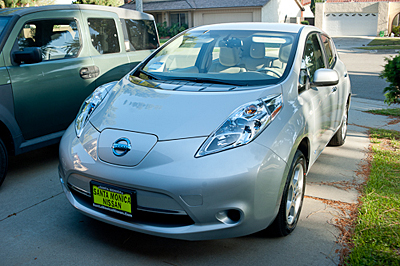 The model we chose was the "no frills" SV version, but this still includes
items such as bluetooth wireless connectivity to cell phones, wireless car
connection to the Nissan "Car Wings" servers, and navigation system. This gives
us some nice capabilities such as the ability to monitor the car's charge
state over the internet, but will also require some careful reading of the
manuals over the next few days.
The model we chose was the "no frills" SV version, but this still includes
items such as bluetooth wireless connectivity to cell phones, wireless car
connection to the Nissan "Car Wings" servers, and navigation system. This gives
us some nice capabilities such as the ability to monitor the car's charge
state over the internet, but will also require some careful reading of the
manuals over the next few days. 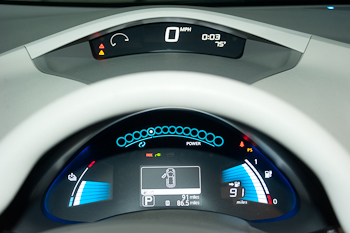 The controls will require some getting used to. It seems that the trend is to try and cram high-tech electronics into the cockpit with only slight resemblence to a traditional car's layout. Some searching is necessary to find the speedometer readout (above the steering wheel) and it's easy to mistake the large digits indicating remaining range with the speedometer, which has no analog-type gage associated with it.
The controls will require some getting used to. It seems that the trend is to try and cram high-tech electronics into the cockpit with only slight resemblence to a traditional car's layout. Some searching is necessary to find the speedometer readout (above the steering wheel) and it's easy to mistake the large digits indicating remaining range with the speedometer, which has no analog-type gage associated with it.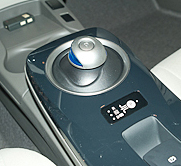 The "shift" lever also has morphed into a knobby joystick with a push-button "park" position in its center.
The "shift" lever also has morphed into a knobby joystick with a push-button "park" position in its center. 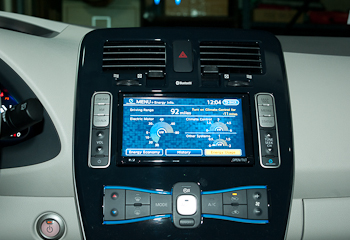 The first 50 miles or so of driving in rush-hour freeway conditions indicate that careful driving can get you the 100 mile/charge promised by the marketeers even though the official sticker now indicates 73 miles estimated range, assuming the range drops off smoothly down to the zero-point on the charge indicator.
The first 50 miles or so of driving in rush-hour freeway conditions indicate that careful driving can get you the 100 mile/charge promised by the marketeers even though the official sticker now indicates 73 miles estimated range, assuming the range drops off smoothly down to the zero-point on the charge indicator. 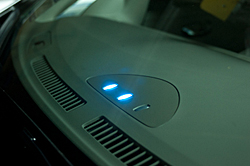 Charging status, however, remains a sore spot. The Clipper Creek charger has minimal status displays -- charging and fault lights. And the car has only 3 flashing lights to indicate its state of charge. This is only marginally better than the sad single flashing light in the Mini-E!
Charging status, however, remains a sore spot. The Clipper Creek charger has minimal status displays -- charging and fault lights. And the car has only 3 flashing lights to indicate its state of charge. This is only marginally better than the sad single flashing light in the Mini-E!